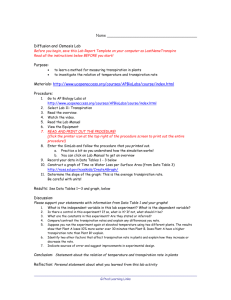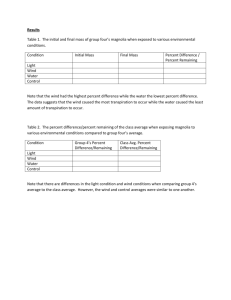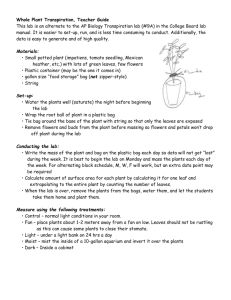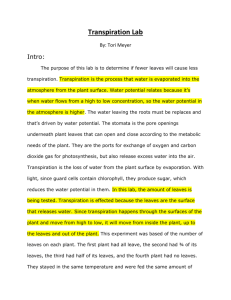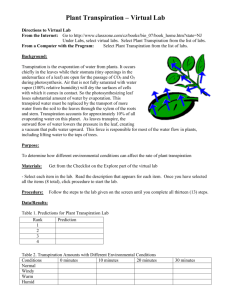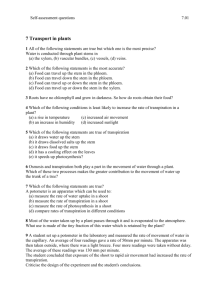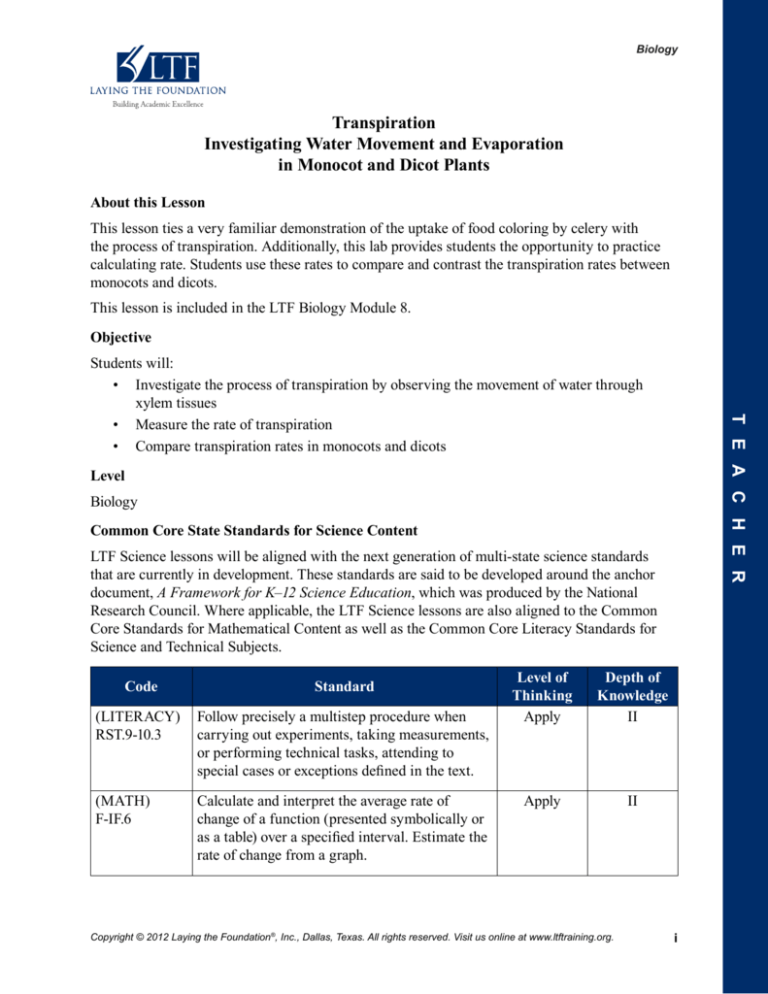
Biology
Transpiration
Investigating Water Movement and Evaporation
in Monocot and Dicot Plants
About this Lesson
This lesson ties a very familiar demonstration of the uptake of food coloring by celery with
the process of transpiration. Additionally, this lab provides students the opportunity to practice
calculating rate. Students use these rates to compare and contrast the transpiration rates between
monocots and dicots.
This lesson is included in the LTF Biology Module 8.
Objective
T E A C H E R
Students will:
• Investigate the process of transpiration by observing the movement of water through
xylem tissues
• Measure the rate of transpiration
• Compare transpiration rates in monocots and dicots
Level
Biology
Common Core State Standards for Science Content
LTF Science lessons will be aligned with the next generation of multi-state science standards
that are currently in development. These standards are said to be developed around the anchor
document, A Framework for K–12 Science Education, which was produced by the National
Research Council. Where applicable, the LTF Science lessons are also aligned to the Common
Core Standards for Mathematical Content as well as the Common Core Literacy Standards for
Science and Technical Subjects.
Code
Standard
(LITERACY)
RST.9-10.3
Follow precisely a multistep procedure when
carrying out experiments, taking measurements,
or performing technical tasks, attending to
special cases or exceptions defined in the text.
(MATH)
F-IF.6
Calculate and interpret the average rate of
change of a function (presented symbolically or
as a table) over a specified interval. Estimate the
rate of change from a graph.
Level of
Thinking
Apply
Depth of
Knowledge
II
Apply
II
Copyright © 2012 Laying the Foundation®, Inc., Dallas, Texas. All rights reserved. Visit us online at www.ltftraining.org.
i
Teacher Overview – Transpiration
Code
Standard
Level of
Thinking
Apply
Depth of
Knowledge
II
(MATH)
S-ID.7
Interpret the slope (rate of change) and the
intercept (constant term) of a linear model in the
context of the data.
(LITERACY)
RST.9-10.7
Translate quantitative or technical information
expressed in words in a text into visual form
(e.g., a table or chart) and translate information
expressed visually or mathematically (e.g., in an
equation) into words.
Apply
II
(MATH)
A-CED.4
Rearrange formulas to highlight a quantity of
interest, using the same reasoning as in solving
equations. For example, rearrange Ohm’s law
V = IR to highlight resistance R.
Apply
II
Connections to AP*
*Advanced Placement and AP are registered trademarks of the College Entrance Examination Board. The College
Board was not involved in the production of this product.
Materials and Resources
Each lab group will need the following:
Additional teacher materials:
aprons
balance
beaker, 250 mL
goggles
graduated cylinder, 10 mL
paper towels
razor blade, new
food color, red
pipette, thin stem
ruler, clear metric
celery stalk
oil, mineral
plant specimen
plant, dicot
plant, monocot
Copyright © 2012 Laying the Foundation®, Inc., Dallas, Texas. All rights reserved. Visit us online at www.ltftraining.org.
ii
T E A C H E R
AP Biology: This lesson addresses concepts contained in Big Ideas 2 and 4 in the revised AP
Biology curriculum under the following sections: 2.A.3, 2.D.1.c, 4.A.4.a-b, and 4.B.2.a.2.
Teacher Overview – Transpiration
Assessments
The following types of formative assessments are embedded in this lesson:
• Visual assessment of measuring techniques used within the lesson
• Sharing class data
The following assessments are located on the LTF website:
• Short Lesson Assessment: Transpiration
• Plants Assessment
• 2006 Biology Posttest, Free Response Question 1
Teaching Suggestions
The celery needs to be fresh for this demonstration to proceed properly. The coloration of the
xylem tissue is easily missed by the untrained eye, so caution students to look closely for the
pinkish-red pigment. To avoid unnecessary stains, mix the food coloring and water ahead of
time. The colored water can be reused by subsequent classes.
Lawn, garden, and house plants that require frequent watering make good specimens for this
activity. Airplane plants can be used as the monocot specimen. The amount of transpiration from
an airplane plant leaf will be very small (typically less than 0.2 mL/24 hrs). One airplane plant
can provide enough leaves for several classes and can be maintained in the classroom. Bamboo
plants have notably large rates of transpiration and are nice specimen for this activity if you find
them locally accessible. If you are using one large plant and having students remove sections,
monitor their cutting to conserve the specimen.
This protocol uses 10 mL graduated cylinders. Alternately, you could use the barrels of 10 mL
disposable syringes placed in test tube racks. You should seal the ends of the syringes shut by
heating the end and pinching it with pliers, or sealing the tip with hot glue. Disposable syringe
barrels are used because they are inexpensive and have 1 mL graduations. Graduated cuvettes
will also work well for this activity. Another choice would be to use regular test tubes by marking
the initial and final levels with a waterproof pen.
Students should not remove their plant specimen once they have applied the mineral oil. If it
becomes necessary to remove the plant the apparatus should be emptied, washed, and refilled
with water before inserting the plant. This precaution will prevent the open end of the stem from
being coated with oil, which would inhibit transpiration.
Display Table 3 for the students to record their group’s data, and for this data to be shared with
the class.
By the time students finish setting up both Part I and then Part II, it will be time to take readings
on Part I. Students will get the final reading for Part II on the second day.
v. 2.0, 2.0
Copyright © 2012 Laying the Foundation®, Inc., Dallas, Texas. All rights reserved. Visit us online at www.ltftraining.org.
iii
T E A C H E R
A variety of plants can be used for Part II, which measures the rate of transpiration. You can
grow your own specimen from bean and corn seeds provided you have an adequate source
of lighting in your classroom. Cucumber plants and tomato plants can be purchased at a local
garden center in season; these garden specimens work well for this activity. The results included
in the answer section were obtained using pansies.
Teacher Overview – Transpiration
Answer Key
Data and Observations
Table 1. The Role of Xylem Vessels in Transpiration
Initial observations of cut end of celery
soft green tissue,
occasional darker green circles
Final observations of cut end of celery
soft tissue is still green,
the occasional circles appear pale red
Length before cutting sections (cm)
27 cm
Length after cutting sections (cm)
24 cm
Rate of water movement (cm/min)
0.15 cm/min
Table 2. Transpiration Rates in Monocot and Dicot Leaves
Dicot
Initial water level (mL)
10 mL
Final water level (mL)
5.6 mL
Volume of water consumed (mL)
4.4 mL
Mass of leaves without stems (g)
3.7 g
Transpiration rate (mL/g/hr)
T E A C H E R
Type of plant
0.05 mL/g/hr
Table 3. Class Data Comparing Transpiration Rates (mL/g/hr)
Group
Average
1
2
3
4
5
6
7
Monocot
Dicot
0.005
0.044
0.052
0.030
0.057
0.003
0.006
0.005
0.046
Copyright © 2012 Laying the Foundation®, Inc., Dallas, Texas. All rights reserved. Visit us online at www.ltftraining.org.
iv
Teacher Overview – Transpiration
Answer Key (continued)
Conclusion Questions
1. The polar water molecules form hydrogen bonds with each other in cohesion and with other
substances in adhesion. This hydrogen bonding, adhesion, and cohesion cause water to move
up the xylem tissues through capillary action.
2. The rate would be lower because the leaves help to draw water upward as they go through
transpiration.
3. If the colored water traveled 3 cm in 20 minutes, in another 20 minutes it would have traveled
another 3 cm for a total of 6 cm.
4. If the colored water travels 0.15 cm/min and the stalk is 27 cm long, it would take 180
minutes to reach the top.
5. Transpiration is the evaporation of water from the leaves of plants. It helps cool the leaf
tissues through evaporation and helps with the uptake of nutrients from the soil.
7. Adhesion is the hydrogen bonding of water molecules to other substances whereas cohesion is
the hydrogen bonding of water molecules to water molecules.
8. Dicot plants have a greater transpiration rate. The dicot transpiration rate in this activity was
0.046 mL/g/hr whereas the monocot transpiration rate was 0.005 mL/g/hr.
9. The plant’s transpiration rate would be greatly reduced or stopped completely.
Copyright © 2012 Laying the Foundation®, Inc., Dallas, Texas. All rights reserved. Visit us online at www.ltftraining.org.
v
T E A C H E R
6. Capillary action is the tendency of water to rise within a thin, narrow tube and is the result
of the hydrogen bonding of water molecules. It is important to plants because it is involved in
the movement of water from the roots to the leaves.
Teacher Overview – Transpiration
Answer Key (continued)
10. Procedures to be followed: (sample)
Fill a 10 mL syringe with water and insert the plant. Using a disposable pipette, raise or lower
the water level until it rests at the 10 mL graduation mark.
Place a thin layer of mineral oil on top of the water to prevent evaporation.
Place a plastic bag over the top of the plant.
Spray a fine mist of water into the bag and seal the bag around the stem of the plant using a
twist tie.
After a 2 minute equilibration period, record the level of the water in the graduated cylinder.
Allow the plant to transpire for 24 hours.
At the end of 24 hours, remove the plant from the syringe. Determine the mass of the leaves
after removing the stems from the specimen. Record the mass of the leaves on the student
answer page.
Determine the amount of water consumed during 24 hours by subtracting the initial reading
from the final reading.
Expected results: There should be no change or very little change in the water level at the end
of 24 hours.
Copyright © 2012 Laying the Foundation®, Inc., Dallas, Texas. All rights reserved. Visit us online at www.ltftraining.org.
vi
T E A C H E R
How and when data will be collected: The water level will be read and recorded on the first
day and then again 24 hours later.
Biology
Transpiration
Investigating Water Movement and Evaporation
in Monocot and Dicot Plants
Transpiration is a necessary plant process in which water evaporates from the leaves of plants.
The process of transpiration uses approximately 90% of the water that enters a plant’s roots.
During transpiration, water moves from the tissues inside the leaf to the external environment by
passing through the stoma. As water evaporates from the leaves of a plant, replacement water is
drawn up by osmosis and capillary action from the tissues below.
Capillary action is the tendency of water to rise within a thin, narrow tube and is the result
of the hydrogen bonding of water molecules. The hydrogen atoms of a water molecule are
slightly positive whereas the oxygen atom is slightly negative. In the property of cohesion, water
molecules cling to one another as the positive hydrogen of one water molecule forms a hydrogen
bond with the negatively charged oxygen of a second water molecule.
When enclosed in a narrow tube—such as the transport vessels, or xylem vessels, of a plant—
water molecules will adhere to the walls of the tube. This property of water is called adhesion.
Collectively, hydrogen bonding, adhesion, and cohesion produce the capillary action of water that
allows it to move up the narrow xylem cells to replace the water evaporated at the surface of the
leaf.
Transpiration plays important roles in plant processes. One role transpiration serves in the plant
is to cool the leaf tissues through the process of evaporation. This evaporative cooling can reduce
heat damage to leaf tissues. A second role of transpiration is to aid in the uptake of nutrients from
the soil. Transpiration of water at the leaves helps establish a concentration gradient that drives
the movement of water from the soil into the roots. As the water moves into the root system,
some nutrients will be carried into the roots. From the roots, water will continue in an upward
movement through the xylem tissues of the stem, eventually reaching the leaf tissues.
Transpiration rates vary from plant species to plant species. Broad leaf, tropical plants tend to
have greater rates of transpiration than narrow leaf plants that survive well in dry environments.
Additionally, the rate of transpiration will vary depending upon environmental factors such as
temperature, humidity, and air movement.
Because water vapor moves from areas of greater concentration to areas of lower concentration,
transpiration rates tend to be greater in hot, dry environments. Many plants have adaptations
that allow them to conserve water through lower rates of transpiration. Thin and narrow leaves,
recessed stoma, and reduced stoma numbers are adaptations that reduce the rate of transpiration.
Copyright © 2012 Laying the Foundation®, Inc., Dallas, Texas. All rights reserved. Visit us online at www.ltftraining.org.
1
Student Activity – Transpiration
Purpose
In this set of activities, you will explore the process of transpiration by observing the movement
of water through xylem tissues and measuring the rate of transpiration.
Materials
Each lab group will need the following:
aprons
balance
beaker, 250 mL
goggles
graduated cylinder, 10 mL
paper towels
razor blade, new
food color, red
pipette, thin stem
ruler, clear metric
celery stalk
oil, mineral
plant specimen
SAFETY ALERT!
» Handle scalpel and razors carefully, taking care to avoid contact
with the sharp edges. Cut away from yourself.
» Food colorings can stain clothes. Wear an apron during this
activity.
Copyright © 2012 Laying the Foundation®, Inc., Dallas, Texas. All rights reserved. Visit us online at www.ltftraining.org.
2
Student Activity – Transpiration
Procedure
Part I: The Role of Xylem Vessels in Transpiration
1. Place 100 mL of distilled water in a 200 mL beaker or similar container. Add 20 drops of red
food coloring and stir. (Your teacher may supply a ready-made solution for you to use.)
2. Obtain a leafy stalk of celery. Cut off the bottom white portion of the celery stalk. Keep this
end piece to use for later color comparisons.
3. Observe the cut end of the stalk, noting its color. Record your observations in Table 1.
4. Place the celery stalk in the colored water. Allow the celery to remain in the water for 20
minutes. During this 20 minute period, you may proceed to Part II.
5. At the end of 20 minutes, remove the celery from the beaker of colored water. Rinse and dry
the bottom end of the stalk. Measure the length of your celery stalk, and record its length in
Table 1.
6. Observe the end of the stalk and note the coloration of the xylem tissue. Record your
observations in Table 1.
7. During the 20 minute wait, the colored water will have traveled up the stem of the celery
through the xylem tissue. To determine how far the colored water has reached, begin cutting
away 1 cm sections from the bottom of the stalk.
After each cut, carefully check the color of the xylem tissue in the stalk. Most of the tissue
will still appear green. Only the xylem cells will contain the colored water. You can use the
initial section removed in Step 2 for color comparison.
If the tissue is still colored, remove another 1 cm section. Repeat until you reach the
uncolored portion of the stalk.
8. Determine the length of the remaining celery stalk. Record this final length in Table 1.
9. Determine the rate of movement of the colored water through the xylem tissue by subtracting
the final length from the initial length of the celery stalk and then dividing by the wait time.
Record the rate of water movement per minute in Table 1.
Copyright © 2012 Laying the Foundation®, Inc., Dallas, Texas. All rights reserved. Visit us online at www.ltftraining.org.
3
Student Activity – Transpiration
Procedure (continued)
Part II: Comparing Transpiration Rates in Monocot and Dicot Leaves
1. Obtain a 10 mL graduated cylinder and fill it with water up to the 8 mL graduation mark.
2. You will be assigned a monocot or dicot specimen to test. Locate the plant specimen your
teacher has assigned to your group. Record which type of plant you have been assigned in
Table 2 on the student answer page.
3. If using a small plant, cut the stem near the soil line. If the plant specimen will be used by
several lab groups, your teacher will assist you as you remove an appropriately sized section
of the plant.
4. Insert the stem of the plant into the water in your graduated cylinder. Using a disposable
pipette, raise or lower the water level until it rests at the 10 mL graduation mark.
5. Place a thin layer of mineral oil on top of the water to prevent evaporation. Once you have
applied the mineral oil, you should not remove or reinsert the stem of the plant.
6. After a 2 minute equilibration period, record the level of the water in the graduated cylinder.
Record your reading in Table 2.
7. Allow the plant to transpire for 24 hours. Once you have set up your specimen, you may
complete Part I.
8. On the second day, read the water level in the graduated cylinder and record this value in
Table 2.
9. Remove the plant from the graduated cylinder. Determine the mass of the exposed leaves
after removing the stems from the specimen and record the mass of the leaves in Table 2.
Do not include any leaves that were below the oil/water line.
10. Determine the amount of water consumed during 24 hours by subtracting the initial reading
from the final reading.
11. Calculate the rate of transpiration per gram of leaf tissue using the following formula:
rate in mL/g/hour = mL of water consumed/mass of leaves/24 hours
12. Share your data with the class as instructed by your teacher to complete Table 3.
Copyright © 2012 Laying the Foundation®, Inc., Dallas, Texas. All rights reserved. Visit us online at www.ltftraining.org.
4
Student Activity – Transpiration
Data and Observations
Table 1. The Role of Xylem Vessels in Transpiration
Initial observations of cut end of celery
Final observations of cut end of celery
Length before cutting sections (cm)
Length after cutting sections (cm)
Rate of water movement (cm/min)
Table 2. Transpiration Rates in Monocot and Dicot Leaves
Type of plant
Initial water level (mL)
Final water level (mL)
Volume of water consumed (mL)
Mass of leaves without stems (g)
Transpiration rate (mL/g/hr)
Table 3. Class Data Comparing Transpiration Rates (mL/g/hr)
Group
Average
1
2
3
4
5
6
7
Monocot
Dicot
Copyright © 2012 Laying the Foundation®, Inc., Dallas, Texas. All rights reserved. Visit us online at www.ltftraining.org.
5
Student Activity – Transpiration
Conclusion Questions
1. Explain why water moved up the celery stalk. What forces were involved in the movement of
the colored water?
2. How would the rate of water movement change if the leaves were removed from the stalk of
celery prior to placing it in the colored water?
3. If you left the celery in the colored water for another 20 minutes, how much farther would the
colored water travel?
4. Calculate how long it would take for the colored water to reach the top of the stalk of celery.
5. What is transpiration, and why is it important in plants?
Copyright © 2012 Laying the Foundation®, Inc., Dallas, Texas. All rights reserved. Visit us online at www.ltftraining.org.
6
Student Activity – Transpiration
Conclusion Questions (continued)
6. What is capillary action, and why is it important in plants?
7. How are adhesion and cohesion different?
8. Which type of plant used in Part II had the greatest rate of transpiration? Support your
answer with data from this activity.
9. Based on the data collected in this activity, what would happen to the rate of transpiration if
the underside of the leaf had been covered with a thin coat of petroleum jelly? Explain your
answer.
Copyright © 2012 Laying the Foundation®, Inc., Dallas, Texas. All rights reserved. Visit us online at www.ltftraining.org.
7
Student Activity – Transpiration
Conclusion Questions (continued)
10. In the space provided, describe an experiment that could test the following hypothesis.
Include details of the procedures to be followed, data to be collected, and results expected.
Hypothesis: If a dicot plant is placed in an environment with high humidity, its transpiration
rate will be lowered.
Copyright © 2012 Laying the Foundation®, Inc., Dallas, Texas. All rights reserved. Visit us online at www.ltftraining.org.
8


